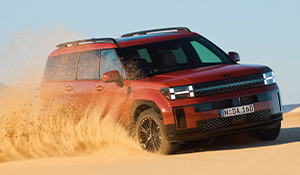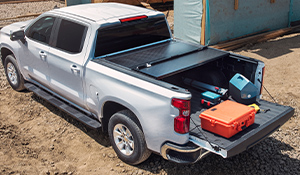TRAVEL FEATURE – Sandy Cape and North Head travel
Located just over 260km from Perth, Jurien Bay is a renowned spot amongst anglers, with offshore fishing that draws game fishers from around the world. The bay is also great for diving, snorkelling, general pleasure boating and even surfing.
All that’s great if you love the water, but if you’re looking for adventures on land, there are a number of great four-wheel drive tracks to be found just north of Jurien Bay – between North Head and Sandy Cape.
THE HEAD AND THE CAPE
North Head, the northernmost point of Jurien Bay, marks the beginning of a 6 kilometre stretch of coast that’s crisscrossed with tracks leading to the Sandy Cape camping area and beyond. You could travel these tracks heading up the coast from North Head, but for this trip, we started from Sandy Cape and headed south down to North Head.
A trek from Sandy Cape to North Head could be done in half a day if you’re short of time or want to keep it simple, but to really explore, make it a couple of days; it’ll be more relaxing, more enjoyable, and you’ll get a chance to develop your 4x4 driving skills, too.
If you like, you could expand the journey by starting further north – kicking off from Green Head (around 30km north of Jurien Bay), with Sandy Cape as the midway point of your journey.
You could also add a visit to Leeman – around 15km north of Green Head - and the nearby limestone caves at Stockyard Gully National Park, or head in the other direction to Cervantes and the amazing desert rock formations at The Pinnacles in Nambung National Park – which is around 45km south of Jurien Bay.

ACCESS
Before you head off, note that Jurien Bay is your nearest fuel stop before Green Head, so make sure you’re carrying enough fuel and other essentials for your journey, no matter how long it is.
Indian Ocean Drive is the inland road that follows the coast in this part of WA. To access the 4x4 tracks at Sandy Cape, head north from Jurien Bay for around half an hour on this road and you’ll get to the turn off to Sandy Cape Road.
As you head west towards the coast on this gravel road, follow the signs until you come to the Sandy Cape Recreation Park camping area.
If you make Sandy Cape the hub for your journey, camping charges at the Recreation Park are just $15 per site per night for two adults and two kids, with an additional $3 for each additional adult and $2 for each extra child. But check the information bay (located on Sandy Cape Road, 1.5km before the campground) for any changes to pricing. Camping at the site is on a first-come, first-served basis, and fills up quickly in summer. Facilities are very basic (chemical toilets, no showers, water or power), so you’ll need to be self-sufficient.
The information bay has all the info you should need for your trip, including rules of conduct for the nature reserve, as well as where you can and can’t fish, as this area is under restriction as part of the Jurien Marine Park.

CHOOSE YOUR OWN ADVENTURE
To get your trek underway, turn off Sandy Cape Road (there are several points before the main campground where you can turn off) and head south west down one of the sand tracks towards North Head If you’re daytripping. If you’re starting from the Sandy Cape campsite, head back down to the information bay – a track starts from near there. Note that all trail options are 4x4 only.
Note also that only registered 4x4s are allowed in the Recreation Park area; trail bikes and quad bikes are not allowed at either Sandy Cape or North Head.
There are so many bush tracks here that you might think it’s easy to get lost, but don't worry: most head in the same direction and meet up at cross roads. However, an off-road GPS will come in handy when travelling around this area.
A simple rule of thumb here is to keep the ocean on your right. You will see heaps of interesting spots along the coast that are worth a look/photo - and the further south you head, the better it gets. Keep to the westernmost tracks to get the best ocean views and photo opportunities, but travel with caution (see WARNINGS).
There are heaps of dead-end tracks up the limestone cliffs that define this region, while other tracks will lead you right down to beautiful sandy beaches. It’s pretty much ‘Choose Your Own Adventure’ stuff, and that’s why taking a couple of days to explore makes it worthwhile.

HISTORY AT the Head
When the terrain and tracks start to get rockier, that means you’re closing in on North Head.
Using the beach (westernmost) track, you will come across some blow holes, and in some cases you will need to drive right next to them to continue onwards. Take care to look where you’re driving here, as the views can be distracting.
Once past this rocky limestone section, you will find yourself back on sand tracks that continue to take you south. Again, keep to the westernmost track to get the best views.
Heading towards the tip of North Head, the track gets narrow, but is still easy to cross. Once through this tight section, you’ll find yourself in a large sand bowl. Forming one side of North Head, this area is almost entirely sheltered against the wind and is a great little spot to take a break.
From the sand bowl, there are two tracks which lead up to the cliff at North Head - the top of this cliff marks the end of the track.

On your way up to the highest point, you will notice two abandoned concrete structures. Built during World War II as part of a radar station for the RAAF, these bunkers housed generators for the radar station, which was there to warn of Japanese aircraft on their way to Perth.
While Perth and this part of Western Australia never came under direct air attack during the war, Japanese raids on the likes of Broome, Wyndham and Port Hedland, and even as far south as Onslow near Exmouth, meant the radar station was considered essential back then.
As well as the bunkers, there’s also an underground tank here that was designed to hold fuel for the generators.
Taking the track between the bunkers to the top of the hill, you will also see the ‘Bartle’ monument. This was placed as a memorial to Robert Bartle, a 23-year-old diver who was killed by a shark at North Head in 1967.
Here, at the top of North Head, the 360 degree views are awesome. You can also really see the raw power of the ocean smashing against the cliffs when the swell picks up. It’s really worth the trek.

BACK TO THE CAPE
On the way down from the top of North Head, take the alternate track back to the sand bowl. From here, look to the south east and you’ll see Jurien Bay in the distance.
From here, backtrack to your start point (being the information board at Sandy Cape campground), basically following the same route, this time keeping the ocean on the passenger’s side.
Alternatively, you can head east, off-roading it the way back to Jurien Bay, accessing some nice long stretches of sandy beach and turquoise water in the process. The early section of this trail is protected by North Head, so it’s perfect for snorkelling and swimming, as the Head forms a lee against heavy winds and rough water, but some winds and swell will get around.

Summing up, these tracks are awesome and keen off-roaders will find them well worth doing. We did our most recent trek when the weather wasn't the best, but despite the overcast conditions and scattered showers, we still loved this track and will be doing it again later in the year - in summer, it will be even better! On this trip, we spotted a sea lion in the heavy swell, so I could just imagine how many more might be seen on a calm day.
There are plenty more 4x4 adventures like this to be had in WA. I’ve done a bunch of them and I look forward to sharing some of my other treks with you.

WARNINGS
Cliff Hazards! Take care when close to the water’s edge on the rockier tracks, as the limestone cliffs are overhanging and could be unstable. It’s also best to keep young kids in the vehicle or hold onto them at all times.
Blowholes! As already mentioned, keep a watch out for blowholes along the rocky trails. Drive with caution, as these can be hard to spot until you’re close to them.
Tides! If you trek down to the beachside trails, be aware of tidal movements, as the beachfront can get very narrow at high tide.
Be aware that fishing is not allowed on North Head. However, further north towards Sandy Cape, it is allowed. Check the information bay at Sandy Cape to know exactly where you can and can’t fish.
On a final note - and this applies to all serious 4x4 treks in WA - make sure you and your vehicle are in shape to tackle these remote areas. Travel carefully and look out for each other when in convoy. If driving solo, take additional care and let others know your travel plans.
Things to do at Sandy Cape and North Head
- 4x4 explore the limestone rock and sand tracks along the coast
- Drive to your own stretch of beach and relax for the day.
- Fishing from beaches (check fishing exclusion zones).
- Explore Jurien Bay Marine Park.
- Snorkelling and scuba diving.
Special thanks to Ronny Dahl of 4 Wheeling in Western Australia for sharing this content. To find out more on this and other 4x4 treks in WA, go to: 4-wheeling-in-western-australia.com

SANDY CAPE and NORTH HEAD – THE ESSENTIALS
Track Difficulty Level:
Easy – Medium. No section is really that difficult, apart from the hill climb, which corkscrews. This may present a challenge for less-confident drivers.
Truck Type:
Sandy Cape Road is a 2WD gravel track with some corrugations until you reach the information bay and campground (1.5km past the information bay). Trails off Sandy Cape Road leading down to North Head are all 4WD only.
Trails are a mix of limestone steps, sand dunes, soft beach sand and rock.
Tyre Pressure:
Recommended PSI is 16-20 for the hard-pack tracks and rock steps. On the beach, if the sand is soft, drop down to 12-13 PSI.
Terrain Conquering:
The mix of terrain will require different methods of driving. This could consist of slowly crawling over rocks, or using more momentum over sand dunes.
If the wrong method is used in the wrong situation, the consequences could be catastrophic. Do your research before you leave and make sure you and your vehicle are equipped to handle all the variables.
NOTE: Terrain will change all the time, due to weather and track usage. Always check sand dunes and other tricky areas such as ruts, rocks and off camber tracks, as well as other unseen or uncertain parts of a track.
What to Bring:
Essential: Air compressor, shovel, rated recovery gear, fuel, sunscreen, bush hat, plenty of water.
Non-Essential: Surf board, fishing gear, sun shelter and camera.
Best Time to Go:
September to April (May to August is still great if there is no rain)
GPS Way points: SANDY CAPE AND NORTH HEAD 4WD TRACK.
Entry to Sandy Cape Recreational Area (Sandy Cape Road):
Latitude: 30°13'10.60"S
Longitude: 115° 2'14.10"E
Head West from here to information bay:
Latitude: 30°11'40.71"S
Longitude: 115° 0'26.45"E
Information Bay way point:
Latitude: 30°11'24.48"S
Longitude: 115° 0'8.60"E
T junction Way Point (Head south to North Head or north west to Sandy Cape):
Latitude: 30°11'22.08"S
Longitude: 115° 0'7.92"E
Sandy Cape camping area:
Latitude: 30°11'3.24"S
Longitude: 114°59'52.76"E
Half way to North Head (way point):
Latitude: 30°12'43.50"S
Longitude: 114°59'55.13"E
Blow Holes:
Latitude: 30°13'30.34"S
Longitude: 114°59'52.72"E
Sandy Cove:
Latitude: 30°13'38.38"S
Longitude: 114°59'42.74"E
Narrow crossing to North Head:
Latitude: 30°13'48.39"S
Longitude: 114°59'48.32"E
Sand Bowl:
Latitude: 30°13'49.55"S
Longitude: 114°59'45.77"E
Bartle Monument & Top of North Head Cliff:
Latitude: 30°13'52.21"S
Longitude: 114°59'41.27"E
Turquoise Beaches Protected from Swell & Wind:
Latitude: 30°13'40.29"S
Longitude: 115° 0'5.00"E
Short cut out to Sandy Cape road (head due north):
Latitude: 30°13'18.21"S
Longitude: 115° 0'8.15"E






















